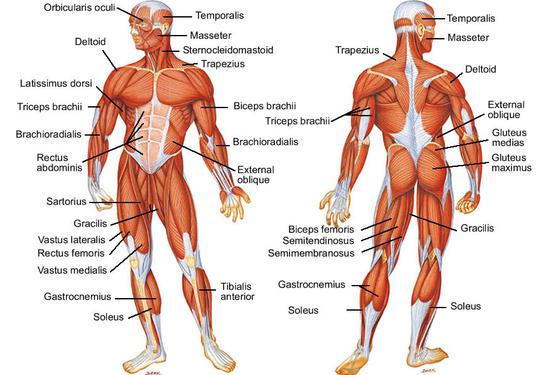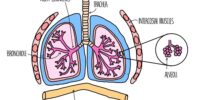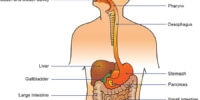Types Of Human Muscles And Movements

The human body is composed of various types of muscles that work together to enable movement and support vital bodily functions. These muscles differ in their structure, function, and location within the body, and understanding their characteristics is crucial for maintaining optimal physical health.
The study of human muscles and movements is a complex and fascinating field that has garnered much attention from researchers and healthcare professionals alike.
In this article, we will explore the different types of human muscles and their respective roles in movement and bodily functions. We will delve into the science behind muscle contraction, examine the differences between voluntary and involuntary movement, and learn about the importance of exercise in building and maintaining healthy muscles.
Furthermore, we will discuss common muscle injuries, their prevention, and the amazing process of muscle repair and regeneration.
By gaining a comprehensive understanding of human muscles and movements, we can better appreciate the intricate workings of our bodies and take steps towards improving our physical well-being.
Key Takeaways
- Human body has three types of muscles: skeletal, smooth, and cardiac.
- Skeletal muscles are responsible for voluntary movement, while smooth muscles are essential for internal organ functioning and cardiac muscles power heartbeat and circulation.
- Muscle contraction is a complex process regulated by the nervous system, and exercise is crucial for muscle development and increasing strength and endurance.
- Understanding the mechanics of voluntary and involuntary movement is essential for preventing muscle injuries, and disruption in the function of cardiac muscles can lead to serious health problems.
Skeletal Muscles: The Body’s Movers and Shakers
Skeletal muscles, responsible for the majority of body movements, are voluntary muscles that contract and relax in response to signals from the nervous system. They are attached to bones by tendons and are responsible for the movements of the skeleton. These muscles are made up of muscle fibers, which are long, cylindrical cells that are capable of shortening or contracting.
Skeletal muscles are also called striated muscles because of their striped appearance under a microscope. These stripes are due to the arrangement of the proteins actin and myosin, which are responsible for muscle contraction.
Skeletal muscles are under conscious control, which means we can choose to move them or not. They are involved in a wide range of movements, from the fine motor skills required for writing and typing to the powerful movements required for running and jumping.
Smooth Muscles: Involuntary Workhorses of the Body
Smooth muscles are essential for the proper functioning of internal organs and play a crucial role in many bodily processes. These muscles are found in the walls of various organs, including the stomach, intestines, bladder, uterus, and blood vessels.
Unlike skeletal muscles, which are under voluntary control, smooth muscles are involuntary and contract and relax automatically, without conscious effort. The contraction of smooth muscles is controlled by the autonomic nervous system, which regulates the activity of internal organs and glands.
Smooth muscles have a unique structure that allows them to perform their specialized functions. They are composed of spindle-shaped cells that have a single, centrally located nucleus. The cells are organized in sheets and layers and are connected by gap junctions, which allow for coordinated contraction of the muscle.
Smooth muscles also contain dense bodies, which act as anchor points for the muscle fibers and help to transmit the force of contraction throughout the tissue. The ability of smooth muscles to contract and relax is essential for many bodily processes, such as digestion, blood flow regulation, and labor and delivery in the uterus.
Cardiac Muscles: Powering the Heartbeat
The rhythmic beating of the heart is powered by the specialized cardiac muscle tissue, which allows for the circulation of blood throughout the body, providing vital oxygen and nutrients to sustain life. These muscles are unique because they are involuntarily controlled by the autonomic nervous system, meaning that they work without conscious thought or effort.
Here are some key characteristics of cardiac muscles:
- They are striated, which means they have alternating light and dark bands under a microscope.
- They are branched, allowing for the transmission of electrical impulses throughout the heart.
- They have a high density of mitochondria, which produce energy for the constant contractions needed to pump blood.
- They have a longer refractory period than other muscle types, which allows for proper filling of the heart chambers before the next contraction.
Overall, the cardiac muscles play a crucial role in maintaining the health and function of the circulatory system. Any disruption in their function can lead to serious health problems, such as arrhythmias or heart failure. Therefore, it is important to understand the unique properties of these muscles and how they contribute to the overall wellbeing of the body.
Voluntary vs. Involuntary Movement
Understanding the mechanics of voluntary and involuntary movement is essential for comprehending the different ways in which the body moves.
Voluntary movement refers to the intentional movement of skeletal muscles, which are attached to bones and facilitate the locomotion of the body. This type of movement is under conscious control and is initiated by the motor cortex in the brain. Voluntary movement is essential for various everyday activities, such as walking, running, and picking up objects. The motor cortex sends signals to the skeletal muscles, which contract and relax in a coordinated manner, producing the desired movement.
On the other hand, involuntary movement refers to the movement of muscles that are not under conscious control. These movements are produced by smooth muscles and cardiac muscles, which are responsible for the contraction and relaxation of internal organs and the heart, respectively. Involuntary movement is controlled by the autonomic nervous system, which regulates various bodily functions, such as breathing, digestion, and heart rate. Involuntary movement is essential for maintaining homeostasis and ensuring the proper functioning of internal organs.
Thus, understanding the differences between voluntary and involuntary movement is crucial for comprehending the mechanics of human movement and the functioning of the human body.
Understanding Muscle Contraction
Muscle contraction is a complex physiological process that is essential for movement. In skeletal muscles, contraction occurs when the muscle fibers are stimulated by a nerve impulse. This impulse triggers the release of calcium ions, which bind to the protein complex troponin-tropomyosin, causing a conformational change that exposes the binding sites on the actin filaments.
The myosin heads then attach to these binding sites, forming a cross-bridge between actin and myosin. The hydrolysis of ATP provides energy for the myosin heads to move, causing the actin filaments to slide over the myosin filaments. As a result, the sarcomere, the basic unit of muscle contraction, shortens, resulting in the contraction of the whole muscle.
Muscle contraction is regulated by the nervous system, with the degree of contraction depending on the number of motor units recruited. Motor units are composed of a motor neuron and the muscle fibers it innervates. The number of motor units recruited determines the force of contraction, with more motor units recruited resulting in a stronger contraction.
The frequency of stimulation also influences the force of contraction, with rapid stimulation resulting in a fused tetanic contraction. Understanding the process of muscle contraction is essential for understanding the different types of movement that can be generated by muscles, such as isotonic and isometric contractions, as well as the role of different muscle types in generating different types of movement.
The Role of Exercise in Building Muscle
Exercise is a crucial factor in the development of muscle tissue and increasing muscle strength.
When individuals engage in physical activity, their muscles experience tension and stress, which causes tiny tears in the muscle fibers.
These tears prompt the body to repair and rebuild the damaged muscle tissue, resulting in stronger and denser muscles.
This process is known as muscle hypertrophy, and it is the body’s natural response to exercise.
To achieve muscle hypertrophy, individuals must engage in regular and consistent physical activity that challenges their muscles.
This typically involves resistance training, which can include exercises such as weightlifting, bodyweight exercises, and resistance band workouts.
In addition to building muscle, exercise also helps to improve muscle endurance, which is the ability of muscles to sustain prolonged periods of physical activity without fatigue.
Overall, exercise is essential for maintaining muscle health and promoting overall physical fitness.
Common Muscle Injuries and How to Prevent Them
Preventing common muscle injuries is crucial for individuals who engage in regular physical activity, as these injuries can hinder muscle growth and overall fitness progress.
One common injury is a strain, which occurs when a muscle is stretched or torn beyond its capacity. This can happen due to improper form during weightlifting or sudden movements during sports. To prevent strains, it is important to gradually increase the intensity and duration of physical activity, as well as ensuring proper form and technique. Stretching before and after exercise can also help to prevent strains.
Another common muscle injury is a sprain, which occurs when a ligament is stretched or torn. This can happen due to sudden movements or impacts during physical activity. To prevent sprains, it is important to wear appropriate footwear and protective equipment, such as ankle braces or knee pads. It is also important to gradually increase the intensity and duration of physical activity and to avoid sudden movements or jerky motions. Stretching and strengthening exercises can also help to prevent sprains by improving flexibility and stability.
By taking these preventive measures, individuals can minimize the risk of common muscle injuries and continue to make progress towards their fitness goals.
The Fascinating Science of Muscle Repair and Regeneration
The process of muscle repair and regeneration is a fascinating area of study that involves intricate cellular processes and signaling pathways. In response to muscle damage, the body initiates a complex series of events that culminate in the repair and regeneration of the affected muscle tissue.
The following are some of the fascinating aspects of muscle repair and regeneration:
- Satellite cells: These are specialized cells that reside in skeletal muscle tissue and play a crucial role in muscle repair and regeneration. Upon muscle damage, satellite cells become activated and proliferate to generate new muscle cells.
- Inflammation: The inflammatory response is a critical component of muscle repair and regeneration. Inflammatory cells are recruited to the site of muscle damage, where they release cytokines and growth factors that facilitate tissue repair.
- Extracellular matrix remodeling: The extracellular matrix (ECM) is a complex network of proteins and other molecules that provides structural support to muscle tissue. Following muscle damage, the ECM undergoes a series of changes that facilitate tissue repair and regeneration.
- Myofiber hypertrophy: In addition to generating new muscle cells, muscle repair and regeneration also involves the growth of existing muscle fibers. This process, known as myofiber hypertrophy, results in an increase in muscle mass and strength.
Overall, the process of muscle repair and regeneration is a complex and fascinating topic that is still being studied by scientists. Understanding the cellular and molecular mechanisms involved in this process can have important implications for the development of new therapies for muscle-related injuries and diseases.
Conclusion
In conclusion, human muscles play a crucial role in our everyday movements and bodily functions. There are three main types of muscles: skeletal, smooth, and cardiac. Skeletal muscles are responsible for voluntary movements, while smooth and cardiac muscles are involuntary and work to maintain vital bodily functions.
Understanding the mechanics of muscle contraction is essential in comprehending how muscles work and how to prevent common muscle injuries. Exercise plays a significant role in building and maintaining muscle strength, and proper injury prevention techniques can help prevent setbacks.
Additionally, the science of muscle repair and regeneration continues to fascinate researchers and medical professionals alike. Overall, the study of human muscles is crucial in understanding our physical abilities and limitations, and continued research in this field can lead to new insights and advancements in healthcare.








